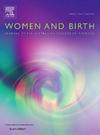Women’s preferences for care delivery during labour and birth in Dutch hospitals: A Q-methodology study
IF 4.4
2区 医学
Q1 NURSING
引用次数: 0
Abstract
Problem
Women’s preferences regarding care delivery during labour and birth remain insufficiently understood. Obtaining a clear understanding of these is important to realise a maternity care system that is future-proof and person-centred.
Background
Dutch maternity care deals with capacity issues due to staff shortages. Despite expected stable birth rates in the coming decades, this situation jeopardises the provision of care during labour and birth that is responsive to women's preferences.
Aim
To systematically study a variety of women’s preferences for care delivery during labour and birth in Dutch hospitals using Q-methodology.
Methods
Q-methodology is a mixed methods approach. Thirty individual interviews were conducted with women living in the south-western Netherlands, during which they ranked 29 statements about their labour and birth preferences from least to most important. By-person factor analysis was performed to identify factors (viewpoints). Interpretation of the viewpoints was done using the qualitative interview data.
Findings
Four viewpoints emerged from the study sample: 1) The personal approach, 2) The empowering approach, 3) The expert approach and 4) The needs-based approach. Consensus statements show a shared preference for respectful interaction. The study cohort emphasises continuity of adequate information provision, while continuity of care professional is deemed less important.
Discussion
Our study was the first to apply Q-methodology to capture women’s preferences for care delivery during labour and birth in Dutch hospitals. Although preferences are individual, they share commonalities in four viewpoints.
Conclusion
The viewpoints provide valuable guidance for the allocation of scarce resources to ensure a maternity care system that is responsive to women’s preferences.
荷兰医院分娩和分娩期间妇女对护理服务的偏好:一项q方法研究。
问题:妇女在分娩和分娩过程中对护理服务的偏好仍未得到充分了解。对这些问题有一个清晰的认识,对于实现一个面向未来、以人为本的产妇保健系统是很重要的。背景:由于工作人员短缺,荷兰的产妇保健处理能力问题。尽管预计未来几十年的出生率将保持稳定,但这种情况危及在分娩和分娩期间提供符合妇女偏好的护理。目的:采用q -方法学系统地研究荷兰医院分娩和分娩期间妇女对护理服务的各种偏好。方法:q -方法学是一种混合方法。研究人员对居住在荷兰西南部的女性进行了30次个人访谈,在此期间,她们对29项关于分娩和生育偏好的陈述从最不重要到最重要进行了排序。通过个人因素分析来确定因素(观点)。对观点的解释是使用定性访谈数据完成的。研究发现:从研究样本中出现了四种观点:1)个人方法,2)授权方法,3)专家方法和4)基于需求的方法。共识声明显示了对尊重互动的共同偏好。研究队列强调充分信息提供的连续性,而护理专业人员的连续性被认为不太重要。讨论:我们的研究是第一个应用q方法来捕捉荷兰医院分娩和分娩期间妇女对护理服务的偏好。尽管偏好是个体的,但它们在四个观点上有共同点。结论:这些观点为稀缺资源的配置提供了有价值的指导,以确保产妇保健系统响应妇女的偏好。
本文章由计算机程序翻译,如有差异,请以英文原文为准。
求助全文
约1分钟内获得全文
求助全文
来源期刊

Women and Birth
NURSING-OBSTETRICS & GYNECOLOGY
CiteScore
7.20
自引率
13.20%
发文量
371
审稿时长
27 days
期刊介绍:
Women and Birth is the official journal of the Australian College of Midwives (ACM). It is a midwifery journal that publishes on all matters that affect women and birth, from pre-conceptual counselling, through pregnancy, birth, and the first six weeks postnatal. All papers accepted will draw from and contribute to the relevant contemporary research, policy and/or theoretical literature. We seek research papers, quality assurances papers (with ethical approval) discussion papers, clinical practice papers, case studies and original literature reviews.
Our women-centred focus is inclusive of the family, fetus and newborn, both well and sick, and covers both healthy and complex pregnancies and births. The journal seeks papers that take a woman-centred focus on maternity services, epidemiology, primary health care, reproductive psycho/physiology, midwifery practice, theory, research, education, management and leadership. We also seek relevant papers on maternal mental health and neonatal well-being, natural and complementary therapies, local, national and international policy, management, politics, economics and societal and cultural issues as they affect childbearing women and their families. Topics may include, where appropriate, neonatal care, child and family health, women’s health, related to pregnancy, birth and the postpartum, including lactation. Interprofessional papers relevant to midwifery are welcome. Articles are double blind peer-reviewed, primarily by experts in the field of the submitted work.
 求助内容:
求助内容: 应助结果提醒方式:
应助结果提醒方式:


